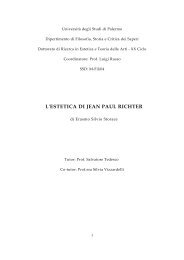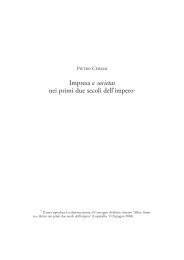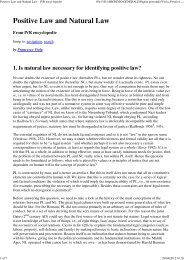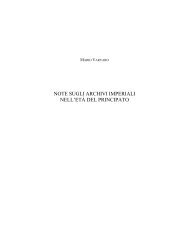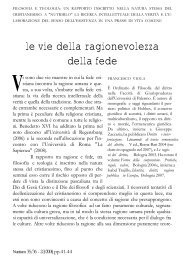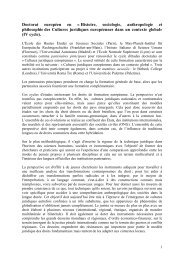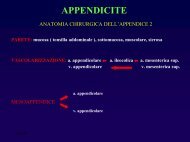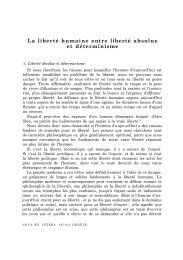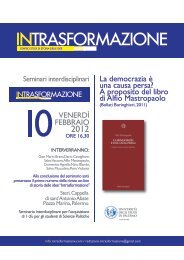F. TERRANOVA, Osservazioni su Gai 2.108 pp. 281 - Università di ...
F. TERRANOVA, Osservazioni su Gai 2.108 pp. 281 - Università di ...
F. TERRANOVA, Osservazioni su Gai 2.108 pp. 281 - Università di ...
You also want an ePaper? Increase the reach of your titles
YUMPU automatically turns print PDFs into web optimized ePapers that Google loves.
ii, o <strong>di</strong> cui lo stesso erede o il legatario è in potestate, e colui che è sottoposto<br />
alla potestà del medesimo può essere chiamato a intervenire all’atto<br />
in funzione <strong>di</strong> testis (e libripens) 9 nella stessa mi<strong>su</strong>ra in cui vengono<br />
iure 10 adhibiti (si sottintende, come testis e libripens) anche lo stesso<br />
erede o il legatario. Ma – aggiunge il giurista – per ciò che riguarda l’erede<br />
e colui che è sottoposto alla <strong>su</strong>a potestà o <strong>di</strong> cui quello (ovvero l’erede)<br />
sarà 11 in potestate, dobbiamo servirci al minimo <strong>di</strong> questo <strong>di</strong>ritto 12<br />
9 Com’è noto, il libripens è considerato, almeno in età classica, alla stregua <strong>di</strong> un testimone.<br />
Così <strong>Gai</strong> 2.107: De libripende eadem quae et de testibus <strong>di</strong>cta esse intellegemus;<br />
nam et is testium numero est. Cfr., in<strong>di</strong>rettamente, anche Tit. Ulp. 20.3.<br />
10 Sul punto cfr. anche <strong>Gai</strong> 2.106 ove in luogo <strong>di</strong> iure, il giurista riporta l’avverbio<br />
recte. Sul significato <strong>di</strong> iure v. infra, nt. 12.<br />
11 Seguiamo la traduzione <strong>di</strong> J. REINACH, <strong>Gai</strong>us: Institutes, Paris 1950, 56. Non compren<strong>di</strong>amo<br />
quale sia la ragione per cui <strong>Gai</strong>o adoperi l’in<strong>di</strong>cativo futuro (erit), in luogo del<br />
presente, come all’inizio del paragrafo (cuiu<strong>su</strong>e heres ipse aut legatarius in potestate est).<br />
Molti stu<strong>di</strong>osi, in realtà, non si interrogano <strong>su</strong>lla questione e traducono il passo adoperando<br />
il presente. Così, ad es., V. SCIALOJA, Diritto ere<strong>di</strong>tario romano. Concetti fondamentali,<br />
Roma 1914, 310; F. DE ZULUETA, The Institutes of <strong>Gai</strong>us, I, Text with critical Notes<br />
and Translation, Oxford 1946, 95. Solleva, invece, il problema R.G. BÖHM, «Emendationes<br />
gaianae», in Labeo 21 (1975), 65-67, che restituisce il testo nel seguente modo: «...sed<br />
tamen quod ad heredem pertinet et omnem quiuis in eius potestate est cuiusque contra is in potestate<br />
est, re uera minime hoc iure uti debemus». L’autore ritiene che erit sia un’abbreviazione<br />
e scioglie la stessa in ‘est re uera’. Sebbene non con<strong>di</strong>vi<strong>di</strong>amo la ricostruzione dello<br />
stu<strong>di</strong>oso, poiché fondamentalmente non c’è nel manoscritto alcun segno <strong>di</strong> abbreviazione<br />
che giustifichi un’integrazione, è degno <strong>di</strong> nota il fatto che egli si interroghi <strong>su</strong>lle ragioni<br />
per cui il giurista adoperi il futuro, in luogo del presente. In argomento v. anche S. SO-<br />
LAZZI, Glosse a <strong>Gai</strong>o, in Scritti <strong>di</strong> <strong>di</strong>ritto romano, VI, Napoli 1972, 364 nt. 294, che attribuisce<br />
la presenza nel testo <strong>di</strong> erit, in luogo <strong>di</strong> est, a un errore <strong>di</strong> un glossatore <strong>di</strong> età postclassica.<br />
Sul punto v. anche infra, nt. 14. Tale errore potrebbe invece, a nostro avviso, ragionevolmente<br />
imputarsi a una svista del copista; svista che ricorre anche in altri luoghi<br />
del manuale [cfr. M. DAVID - H.L.W. NELSON, <strong>Gai</strong> Institutionum commentarii IV, Kommentar<br />
(2. Lieferung), cit., 321 s.]. Si potrebbe, inoltre, spiegare l’assenza del riferimento<br />
a ‘qui... in eiusdem potestate est’, ipotizzando che la presenza <strong>di</strong> alcune parole simili nella<br />
porzione <strong>di</strong> testo precedente (cfr. in eius potestate est) abbia determinato, per omoteleuto,<br />
la mancata trascrizione da parte del copista dell’inciso.<br />
12 Sul valore da attribuire a minime v. infra, § 5 e ivi nt. 83. L’impiego dell’espressione<br />
iure uti – presente anche in altri luoghi del manuale (cfr., ad es., <strong>Gai</strong> 1.53, 80, 2.154,<br />
195, 227, 3.179, 224, 4.163) e adoperata nel Corpus iuris civilis per in<strong>di</strong>care il <strong>di</strong>ritto vigente,<br />
ma risalente a età repubblicana – esprime originariamente una ‘concezione strumentale<br />
del <strong>di</strong>ritto’. Così R. SANTORO, Sul Ius Papirianum, in AA. VV., Mélanges de droit<br />
romain et d’histoire ancienne. Hommage à la mémoire de André Magdelain, Paris 1998, 399-<br />
416; ID., A<strong>pp</strong>io Clau<strong>di</strong>o e la concezione strumentalistica del ius, in AUPA 47 (2002), 295-<br />
365 (con letteratura citata a p. 295 nt. 1) e, da ultimo, ID., ‘Iure uti’ in Ter., Hec. prol. II,<br />
287



